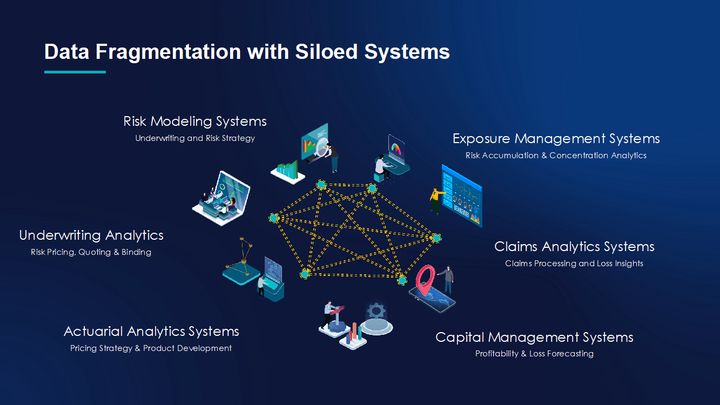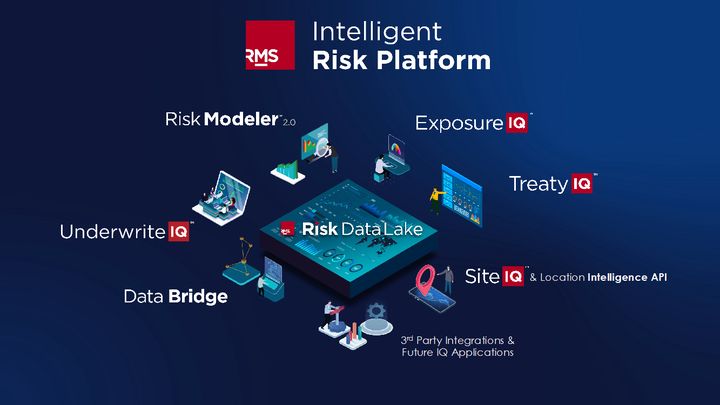There’s no doubt that we now have more data and apps at our fingertips than ever before to help us make decisions. But for financial services, reinsurance, insurance, or brokerage companies, this often means you have to deal with multiple disconnected systems across the departments that are driving critical business decisions.
For the insurance industry, at RMS® we sometimes see a decision-making center – such as underwriting, exposure management, risk analytics, cat modeling, or actuarial – use a system built by their in-house teams. And sometimes there are various vendors that play a role, with each system creating and storing its own version of data. Then, with every update, each system creates a distinct version of data that other systems can’t access.
Anyone could look at this picture and easily see the issue: None of these systems are built to house your “golden copy” of the data, and none are designed to integrate through open APIs (application programming interfaces) to other solutions – to get this golden copy of data and update it once reconciled.
This is vital; the integrated ecosystem of tools needs to utilize this single version of truth. In this blog, we’ll explore an approach that can help solve the issue of siloed systems – because it isn’t impossible to get this coveted golden copy.
Siloed Systems Lead to Data Drift
Imagine you are working for an insurance or reinsurance company. Risk trading decisions are complex. Teams collaborate across different disciplines, with regional and corporate departments, and across lines of businesses. Each team or discipline has its own system that looks to optimize its part of the overall risk puzzle.
However, they are all siloed systems and require a copy of your portfolios, accounts, policies, treaties, and more. Each group of users then makes its own edits and iterates on its own snapshot.
Give it a few cycles and all the data start to drift and fork away. Each system has an incomplete view. Each copy gets out of date and is inconsistent. Furthermore, no copy represents your complete golden copy of the data or single version of the truth. You end up with the data fragmentation “spaghetti” of siloed systems – see diagram below.

I have heard several versions of this story but here’s one: Imagine it’s September 2021, and Category 4 Hurricane Ida is unfolding. The clock is ticking as your teams try to understand losses from the event. As the event unfolds:
- Teams are trying to set underwriting moratoriums.
- Analysts are scrambling to log in to various weather report sites to find, download, and use the latest tracks and shapefiles that can help understand the losses against your various portfolios in various business lines.
- Claims teams are trying to figure out the best places to send their adjusters.
During all this, your CEO is expected to report on losses to shareholders and to the board, but the cat modeling and exposure management systems are reporting concerningly different loss expectations. These systems have copies of the same portfolios, but the copies are from different times between separate systems.
They contain different exposures and policies with multiple edits across various systems – which has caused significant information drift.
Meanwhile, the hurricane seems to be changing direction from what the initial tracks had shown. It is getting closer, and the pressure for accuracy is building. But sadly, there isn’t much anyone can do.
We Can Do Better: RMS Intelligent Risk Platform
Data inconsistency issues can quickly snowball into bigger problems. These range from missed opportunities, lost revenue, and reduced customer experience through to suboptimal operating efficiency, reputational risk, and costly financial mistakes. An IBM study refers to the data-quality issues as a US$3 trillion problem in the U.S. alone. We can surely do better!
The RMS Intelligent Risk Platform™ (IRP) is built to resolve the issues arising from siloed risk systems. With the RMS IRP, your exposure management teams, risk modeling teams, underwriters, and treaty managers all have access to a unified data store that contains a shared copy of your data: your portfolio, account information, policies, treaties, and more.
Simply put, if you import a snapshot of new accounts into the RMS Risk Modeler™ modeling application on the RMS IRP, that data will be immediately available to both RMS ExposureIQ™ and RMS UnderwriteIQ™ applications.
This is possible thanks to a shared data model we have created that allows all applications to speak the same language. The power of this platform comes alive even more when in-house and third-party applications also use it to store portfolios and accounts of exposures, policies, and treaties.

Data inconsistency issues are certainly not specific to risk analytics. They plague almost every single domain of analytics, and examples are not hard to find. Whether it is inconsistency in geocoding accuracy that caused the demolition of the wrong structure or simple spelling mistakes that cause loss of life, there are many examples of how data quality widely impacts critical outcomes.
You can avoid these mistakes with open, modular designs – as used by the RMS Intelligent Risk Platform. It gets you closer to the desired “golden copy” by bringing together a trusted data repository, collaborative applications, powerful analytics, and helpful risk management tools.
Learn more about the RMS Intelligent Risk Platform and the RMS IQ applications that run on it on our website.










